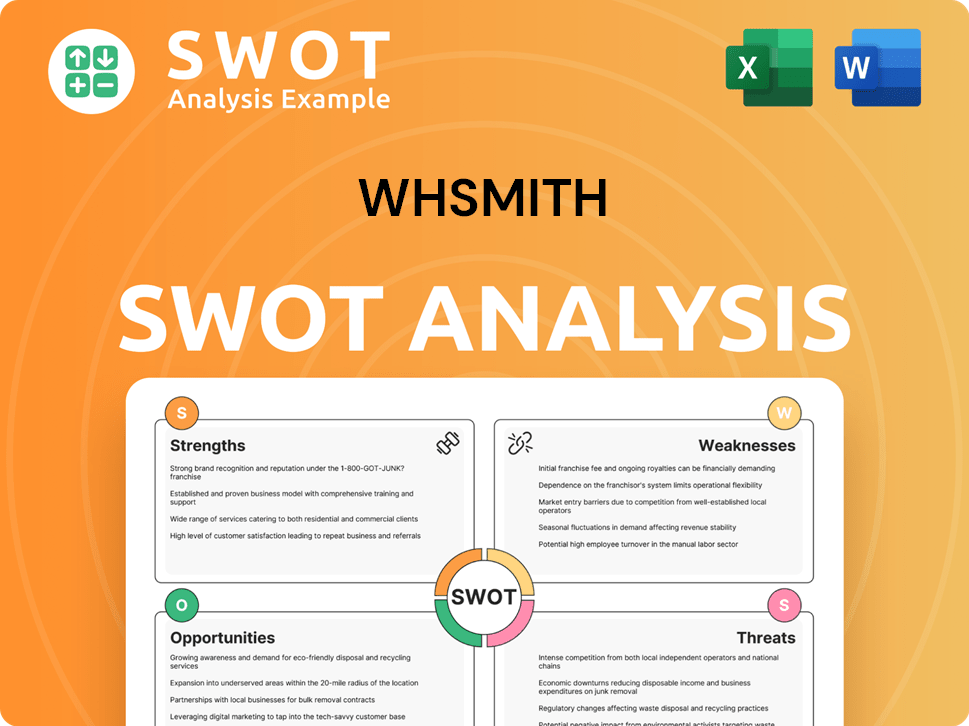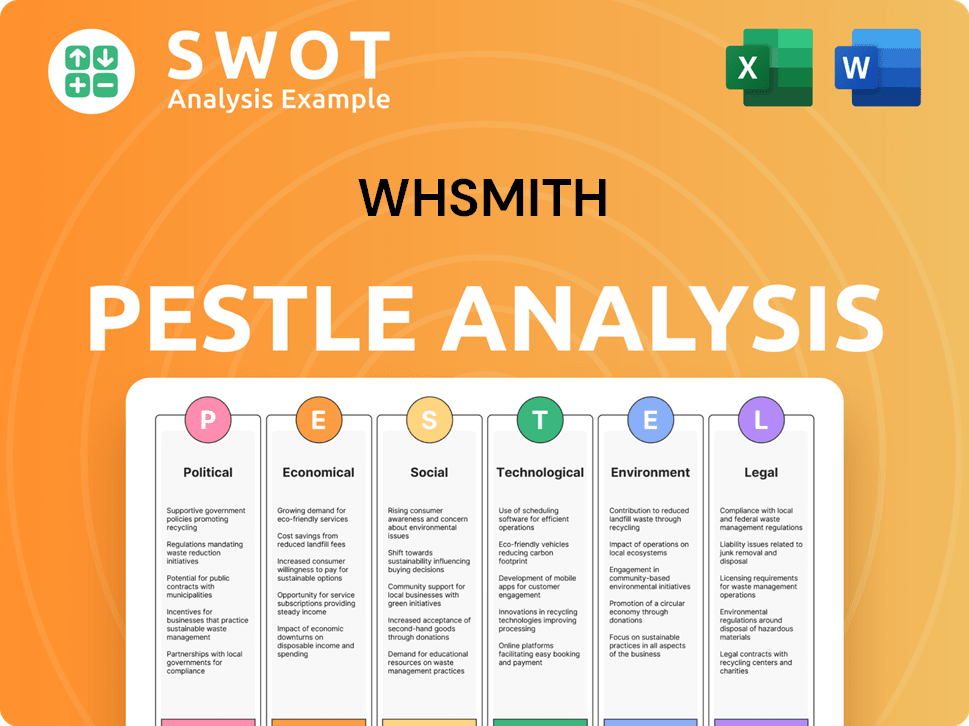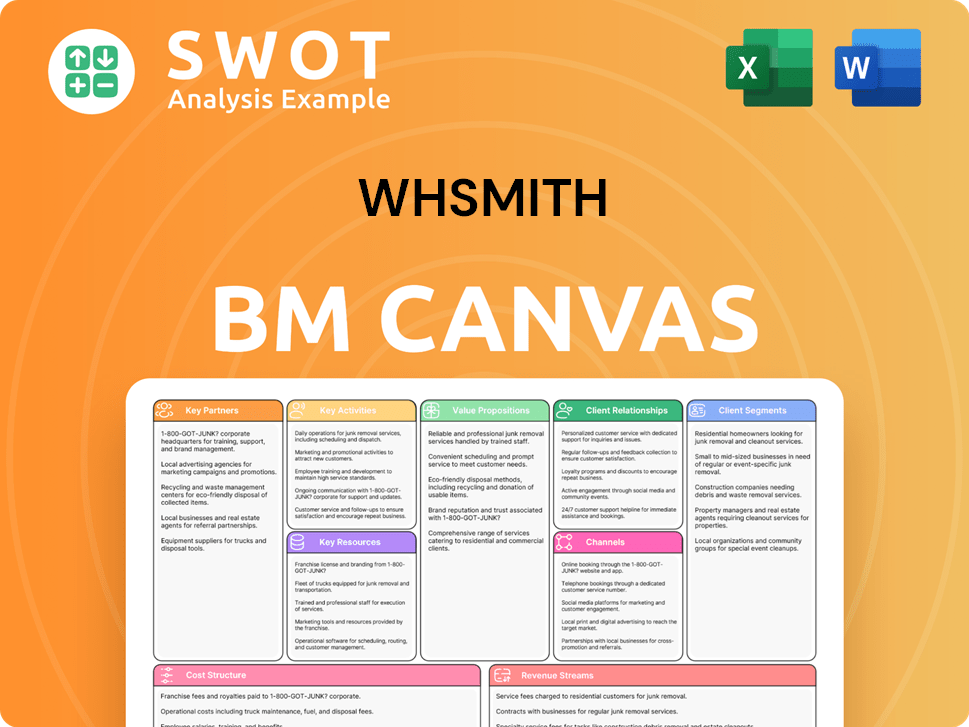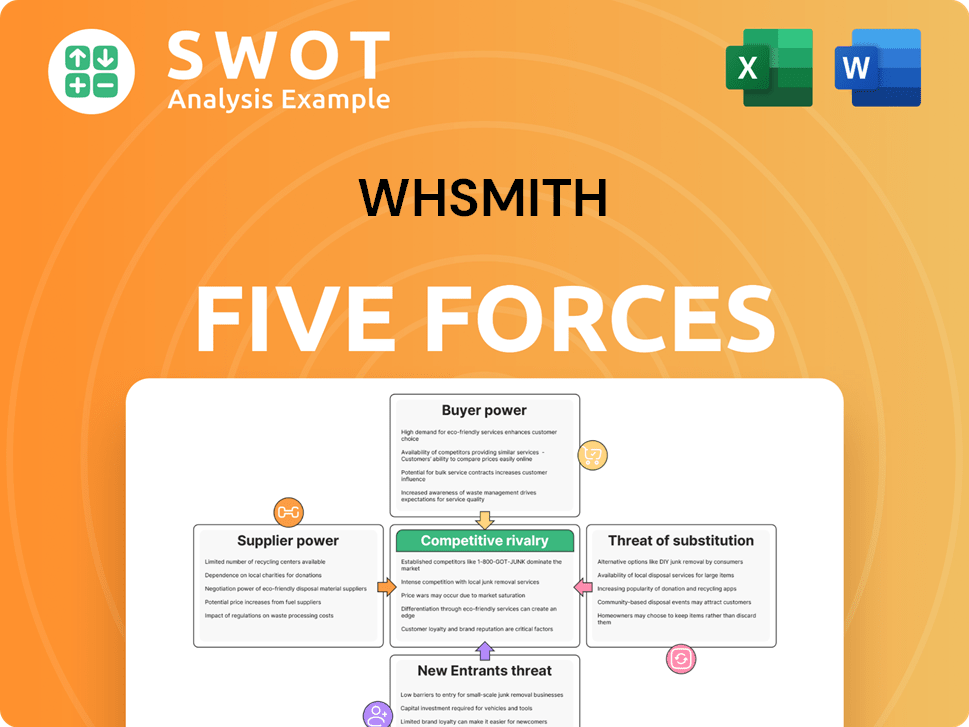WHSmith Bundle
How is WHSmith Dominating the Travel Retail Market?
From a humble newsstand in 1792 to a global travel retail powerhouse, WHSmith's journey is a masterclass in strategic adaptation. The recent sale of its UK High Street business signals a bold move, but what sales and marketing strategies are driving its remarkable transformation? How has this iconic brand reshaped its WHSmith SWOT Analysis to thrive in today's dynamic retail landscape?

This analysis delves into WHSmith's current sales strategy and marketing strategy, exploring its innovative business model and how it captures customers. We'll examine its customer acquisition strategies, digital marketing initiatives, and in-store marketing tactics, offering insights into its brand positioning and expansion strategy. Understanding WHSmith's approach provides valuable lessons for anyone navigating the complexities of the UK retail market and beyond, including effective bookstore marketing techniques.
How Does WHSmith Reach Its Customers?
The sales strategy of WHSmith revolves around a blend of online and offline channels, with a strong focus on its travel retail sector. This strategy is designed to capitalize on high-margin markets and increase spending per passenger. The company has strategically shifted its focus, reducing its high street presence to concentrate on travel retail operations.
WHSmith's approach to sales incorporates both physical stores and digital platforms. The company operates a vast network of stores in travel hubs like airports and train stations. Simultaneously, it leverages e-commerce platforms to reach customers online. This omnichannel strategy is supported by strategic partnerships and a strong expansion plan, particularly in North America.
The company's primary sales channels are designed to maximize revenue and customer engagement. WHSmith's retail strategy has evolved to meet changing consumer behaviors. This includes a significant investment in digital platforms and a focus on high-growth areas like travel retail.
WHSmith operates physical stores in travel hubs across 32 countries. As of August 31, 2024, the company had 594 Travel stores in the UK and nearly 700 internationally, including 341 in North America. The company plans to open approximately 40 net new Travel stores in the current financial year, with around 50 new stores planned annually in North America for the next couple of years.
WHSmith utilizes e-commerce platforms to reach customers online. These include whsmith.co.uk, funkypigeon.com, and cultpens.com. The whsmith.co.uk platform was relaunched in 2019 to enhance the shopping experience and expand product ranges. These digital initiatives are key components of the WHSmith marketing strategy.
Partnerships are integral to WHSmith's sales strategy. The company operates M&S stores and Costa Coffee concessions within its travel locations. Trials with Toys R Us and Holland & Barrett are also underway. These collaborations enhance the customer experience and drive sales. Brief History of WHSmith offers a deeper dive into the company's evolution.
Total travel revenue for the year ending August 31, 2024, increased by 11% to £1.466 billion. The high street business saw a 4% dip in sales to £452 million in the same period. This shift highlights the company's focus on the travel retail market and its impact on WHSmith's financial performance and sales.
WHSmith's sales channels are designed to maximize revenue and customer engagement through a combination of physical stores, online platforms, and strategic partnerships. The company's retail strategy has evolved to meet changing consumer behaviors, including significant investment in digital platforms and a focus on high-growth areas like travel retail.
- Expansion in Travel Retail: Aggressive growth in travel locations, especially in North America, with plans to open around 50 new stores annually.
- Digital Investments: Relaunch of whsmith.co.uk to enhance the shopping experience and expand product ranges.
- Strategic Partnerships: Collaborations with brands like M&S, Costa Coffee, Toys R Us, and Holland & Barrett to drive sales and enhance customer experience.
- Focus on High-Margin Markets: Prioritizing the travel retail sector to increase spend per passenger.
WHSmith SWOT Analysis
- Complete SWOT Breakdown
- Fully Customizable
- Editable in Excel & Word
- Professional Formatting
- Investor-Ready Format

What Marketing Tactics Does WHSmith Use?
The company employs a multifaceted marketing strategy, focusing on both digital and in-store tactics to boost brand awareness, generate leads, and drive sales. This approach is particularly evident in its travel retail sector, where it has been expanding its presence and marketing efforts. The company's recent strategic shift to concentrate solely on travel retail, following the sale of its high street business in March 2025, further underscores this focus.
A key element of the company's marketing strategy is its innovative retail media network, WHS Media, launched in January 2025 in partnership with SMG. This initiative aims to connect brands with the estimated 900 million travelers annually passing through its locations in the U.S. and Canada. The network provides advertising opportunities across various touchpoints, including in-store and digital media.
Beyond its retail media network, the company utilizes digital marketing strategies such as content marketing, SEO, paid advertising, and email marketing. It also engages in social media marketing to connect with its audience. Furthermore, traditional media tactics like events and in-store sampling are employed, as seen in its partnership with N2O for experiential marketing campaigns across UK stores.
The WHS Media network, launched in January 2025, targets the travel retail sector. It offers advertising opportunities across various touchpoints within the company's locations in the U.S. and Canada.
Digital tactics include content marketing, SEO, paid advertising, and email marketing. Social media marketing is also used to engage with its audience and drive online sales.
In-store sampling and experiential marketing are utilized to engage customers. Partnerships, such as the one with N2O, provide new marketing channels.
The company uses data and analytics to understand customer needs and optimize its marketing mix. The Xiatech partnership supports this by integrating data for a unified view.
The strategic pivot to travel retail allows for concentrated marketing efforts. The goal is to capture growth opportunities and increase spend per passenger.
Collaborations with companies like SMG and N2O expand marketing reach. These partnerships provide access to new audiences and channels.
The company's partnership with Xiatech, announced in June 2024, demonstrates its commitment to data-driven marketing. The Xfuze platform integrates data to create a single view of customer, sales, product, and inventory information. This supports operations and decision-making across its global business, aiming to reduce costs and improve efficiency. This approach is crucial for understanding customer behavior and optimizing the company's Growth Strategy of WHSmith.
- Data integration enhances the company's ability to respond to market changes.
- Improved data analysis supports better decision-making in marketing campaigns.
- A unified view of data helps in understanding customer preferences and trends.
- Data-driven insights enable the company to optimize its promotional offers and discounts.
WHSmith PESTLE Analysis
- Covers All 6 PESTLE Categories
- No Research Needed – Save Hours of Work
- Built by Experts, Trusted by Consultants
- Instant Download, Ready to Use
- 100% Editable, Fully Customizable

How Is WHSmith Positioned in the Market?
The brand positioning of WHSmith is undergoing a significant transformation, shifting from a traditional UK high street retailer to a leading global travel retailer. This strategic move is crucial, especially with the sale of its UK high street business in March 2025, which will see those stores rebranded, effectively removing the WHSmith name from the high street. The core brand message now centers on serving customers 'for every one of life's journeys,' primarily in high-footfall travel environments.
The visual identity and tone of voice are adapting to this travel-centric focus. While a trial rebrand featuring a shortened 'WHS' logo in a bold typeface was tested in early 2024, it was limited to only 10 locations. This indicates a cautious approach to brand consistency while exploring modern aesthetics. The brand aims to be a 'one-stop-shop' for travelers, enhancing the customer experience by offering a broad range of products and services tailored to their needs during transit.
WHSmith's Revenue Streams & Business Model of WHSmith highlights the company's strategic shift. The company is focusing on convenience, accessibility, and a curated selection of travel essentials, including books, stationery, magazines, newspapers, confectionery, and travel accessories. This approach is designed to meet the needs of travelers in high-traffic locations such as airports, train stations, and hospitals. The company's ability to adapt its offerings to specific market demands is a key differentiator.
WHSmith primarily targets travelers in airports, train stations, and hospitals. Their target audience includes a broad range of demographics, all seeking convenience and essential products during their journeys. The company's focus is on providing a curated selection of items tailored to the needs of these travelers.
The core message revolves around serving customers 'for every one of life's journeys.' This is reinforced by a focus on convenience, accessibility, and a curated selection of travel essentials. The brand aims to be a one-stop-shop for travelers, enhancing their experience during transit.
WHSmith differentiates itself through its extensive presence in travel hubs and its ability to adapt its offerings to specific market demands. The company optimizes space, increases spend per passenger, and grows its presence in new and existing markets. This focus on profitability within its travel division is key.
WHSmith's travel division saw total revenue increase by 11% to over £1.4 billion in the year ended August 31, 2024. This robust financial performance underscores the company's success in the travel retail market. The company's expansion of its food offerings, such as 'Smith's Family Kitchen,' further supports its brand positioning.
WHSmith's WHSmith sales strategy and WHSmith marketing strategy are closely aligned with its brand positioning. Key initiatives include:
- Expanding its presence in travel hubs.
- Adapting offerings to meet specific market demands.
- Optimizing space and increasing spend per passenger.
- Launching new food-to-go ranges and cafe formats to meet evolving customer demands.
WHSmith Business Model Canvas
- Complete 9-Block Business Model Canvas
- Effortlessly Communicate Your Business Strategy
- Investor-Ready BMC Format
- 100% Editable and Customizable
- Clear and Structured Layout

What Are WHSmith’s Most Notable Campaigns?
The sales and marketing strategy of WHSmith is currently heavily focused on its travel retail division. This strategic shift includes significant investment in expanding its 'one-stop-shop' format and enhancing its product offerings to cater to travelers. These initiatives are designed to boost revenue and capitalize on the increasing demand within the travel sector.
Key campaigns include the rollout of its own-brand food range and the expansion of partnerships with other brands. These efforts aim to increase customer spending and attract new customer segments. WHSmith's digital marketing initiatives, such as the launch of a retail media network, further support these goals by providing new revenue streams and enhancing the in-store experience. The Target Market of WHSmith is also a key consideration in these campaigns.
The success of these campaigns is measured by increased revenue, trading profit, and the expansion of new store openings. WHSmith's strategic focus on travel retail is evident in its marketing and sales strategies, designed to meet the needs of travelers while driving financial growth.
The 'one-stop-shop' format is a primary focus, aiming to provide a comprehensive range of travel essentials. This includes expanding the range of food, health, and beauty products. This strategy aims to increase the spend per passenger by offering a wider variety of products in convenient locations.
The launch of 'Smith's Family Kitchen' in May 2024, with approximately 30 products, represents a significant investment in its food offerings. The 'Smith's Kitchen' cafe format, launched in August 2024, further supports this by offering hot food and baked goods. This expansion aims to cater to the needs of travelers.
Collaborations with brands like Toys'R'Us, M&S, Costa Coffee, and Holland & Barrett are crucial. The Toys'R'Us partnership is expanding to 80 stores by the end of 2024. These partnerships boost brand visibility and credibility, driving footfall and sales.
The launch of the WHSmith North America Retail Media Network in January 2025 is a key campaign. This network allows brands to advertise directly to travelers. This initiative aims to generate new revenue streams and enhance the in-store experience.
The success of these campaigns is measured by several key performance indicators. WHSmith's financial performance is a testament to its effective sales and marketing strategies.
- Total travel revenue up 11% to £1.466 billion in the year ended August 31, 2024.
- Travel trading profit up 15% to £189 million.
- A strong pipeline of new store openings, with over 90 new travel stores won and yet to open globally.
- Approximately 60 new travel stores are planned in North America.
WHSmith Porter's Five Forces Analysis
- Covers All 5 Competitive Forces in Detail
- Structured for Consultants, Students, and Founders
- 100% Editable in Microsoft Word & Excel
- Instant Digital Download – Use Immediately
- Compatible with Mac & PC – Fully Unlocked

Related Blogs
- What are Mission Vision & Core Values of WHSmith Company?
- What is Competitive Landscape of WHSmith Company?
- What is Growth Strategy and Future Prospects of WHSmith Company?
- How Does WHSmith Company Work?
- What is Brief History of WHSmith Company?
- Who Owns WHSmith Company?
- What is Customer Demographics and Target Market of WHSmith Company?
Disclaimer
All information, articles, and product details provided on this website are for general informational and educational purposes only. We do not claim any ownership over, nor do we intend to infringe upon, any trademarks, copyrights, logos, brand names, or other intellectual property mentioned or depicted on this site. Such intellectual property remains the property of its respective owners, and any references here are made solely for identification or informational purposes, without implying any affiliation, endorsement, or partnership.
We make no representations or warranties, express or implied, regarding the accuracy, completeness, or suitability of any content or products presented. Nothing on this website should be construed as legal, tax, investment, financial, medical, or other professional advice. In addition, no part of this site—including articles or product references—constitutes a solicitation, recommendation, endorsement, advertisement, or offer to buy or sell any securities, franchises, or other financial instruments, particularly in jurisdictions where such activity would be unlawful.
All content is of a general nature and may not address the specific circumstances of any individual or entity. It is not a substitute for professional advice or services. Any actions you take based on the information provided here are strictly at your own risk. You accept full responsibility for any decisions or outcomes arising from your use of this website and agree to release us from any liability in connection with your use of, or reliance upon, the content or products found herein.